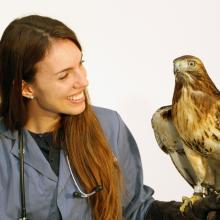During my time here at Tsolum Veterinary Clinic, I have been lucky enough to have exposure to various diagnostic imaging modalities, one of which has been ultrasound. Both large and small animal ultrasound practice with various veterinarians has made me more comfortable working with this imaging modality, and has been an important part of continuing education since the amount of time we spend on this during classroom hours is limited. In reality, without hours and hours of hands-on practice, classroom learning only gets you so far, and this is the perfect example of that!
 More specifically, these past few weeks, I have had the opportunity to use the large animal ultrasound machine on several occasions, which is something that was completely new to me. In the photo to the left, I am geared up and looking like a ghost buster… But in fact, I am wearing a portable ultrasound machine used in large animal medicine to help estimate which point in the estrus cycle a dairy cow is at during the time of palpation – a skill which becomes critical for timing of breeding. Prior to using these ultrasound machines, I had to review my anatomy of ovarian structures within the cow. Next, I practiced rectal exams on several dry (non-pregnant) cows to review my phase 2 Theriogenology palpation skills. After practicing on dozens of cows, I reviewed the estrous cycle (heat cycle) in cows, recognizing that they enter estrus every 18-24 days with an end goal of becoming pregnant after breeding. Estrus itself lasts about 18 hours in these animals, and ovulation occurs about 12 hours after the end of estrous. Optimal time to breed in these cows is towards the end of the 18-hour estrous period. As such, it becomes critically important for the veterinarian and farmers to work together to detect signs of estrus (like mounting and standing behaviours) in order for cows to be inseminated at the appropriate time during their cycle.
More specifically, these past few weeks, I have had the opportunity to use the large animal ultrasound machine on several occasions, which is something that was completely new to me. In the photo to the left, I am geared up and looking like a ghost buster… But in fact, I am wearing a portable ultrasound machine used in large animal medicine to help estimate which point in the estrus cycle a dairy cow is at during the time of palpation – a skill which becomes critical for timing of breeding. Prior to using these ultrasound machines, I had to review my anatomy of ovarian structures within the cow. Next, I practiced rectal exams on several dry (non-pregnant) cows to review my phase 2 Theriogenology palpation skills. After practicing on dozens of cows, I reviewed the estrous cycle (heat cycle) in cows, recognizing that they enter estrus every 18-24 days with an end goal of becoming pregnant after breeding. Estrus itself lasts about 18 hours in these animals, and ovulation occurs about 12 hours after the end of estrous. Optimal time to breed in these cows is towards the end of the 18-hour estrous period. As such, it becomes critically important for the veterinarian and farmers to work together to detect signs of estrus (like mounting and standing behaviours) in order for cows to be inseminated at the appropriate time during their cycle.
In all of these cases, the importance of the ultrasound machine and manual palpation skills become critical during herd health checks to ensure that the cows whom the farmer thinks are pregnant are indeed pregnant and as far along in their pregnancy as believed according to breeding date. In the case that the cows are not pregnant, steps are taken in order for the cow to enter the desired heat cycle again (prostaglandin is given at the appropriate dosage and time to eliminate any corpus luteum on the ovary) so that she can be successfully bred on the next cycle.
 Without an ultrasound, a skilled practitioner can usually detect ultrasound by days 30-35 based on a small amount of fluid fill in the uterus. However, pregnancy detection in early pregnancy can be much more accurate when combined with ultrasound use, which can detect pregnancy as early as 20 days post-insemination! Among all of the structures visible through the cows approximate 283-day pregnancy, detection of the heartbeat at about day 20 was the coolest thing for me to see. A little beating dot on the ultrasound goggles… such a rewarding and mesmerizing thing!
Without an ultrasound, a skilled practitioner can usually detect ultrasound by days 30-35 based on a small amount of fluid fill in the uterus. However, pregnancy detection in early pregnancy can be much more accurate when combined with ultrasound use, which can detect pregnancy as early as 20 days post-insemination! Among all of the structures visible through the cows approximate 283-day pregnancy, detection of the heartbeat at about day 20 was the coolest thing for me to see. A little beating dot on the ultrasound goggles… such a rewarding and mesmerizing thing!
(Ultrasound picture from: uk-ireland.bcftechnology.com)
